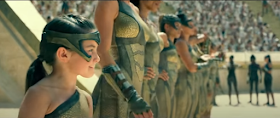Wonder Woman 1984 was an eagerly anticipated release. The sequel
was first scheduled for release in November 2019. It also comes at a tumultuous
time for DC’s Expanded Universe. Aside from the underperforming Birds of Prey,
WW ’84 was the first of those films to come out since Shazam! in spring 2019;
almost an entire lifetime ago in Covid time. On top of that, the film was a
sacrificial lamb of sorts to test out their new plan of releasing films in the
theatre and their streaming platform, HBO Max. Was it worth it? Did the film
benefit from those extra months in post-production?
Patty Jenkins returns as director as well as working on the
story and screenplay with Geoff Johns and David Callaham. None of them were credited
with the story or screenplay for the first film. Considering both films bragged
about the number of women involved with the production, it’s amazing they
couldn’t come up another female writer anywhere in Hollywood. This film is less
disjointed than the last one. The final battle doesn’t feel like a sudden chore
that has to be done for a superhero film. WW84 is much more
ambitious. While the commercials advertise two villains, the real villain is
less able to spot and far more sinister; greed especially greed fueled by capitalism.
Perhaps they were two ambitious. Brief flashes of Maxwell Lord (Pedro Pascal)
suffering racism and lightening his hair to blend in hint at what could have
been a deeper sympathetic story. Barbara Ann Minerva (Kristen Wiig) suffers
even more from missed opportunities.
Minerva is a standard trope in this film; “From Nobody to
Nightmare” as TvTropes calls it. She’s an over-achieving lonely scientist who
just wants a friend. Of course, anyone would want to emulate Diana (Gal Gadot).
She appears to be perfect; the total opposite of Minerva even while claiming
otherwise. However, many viewers, even those not familiar with Minerva’s relationship
with Etta Candy (Lucy Davis) in the comics, thought they saw more between Minerva
and Diana, a palpable chemistry. In the source material, Diana is a confirmed
bisexual with at least one girlfriend. The films appear less true to her roots.
While it’s fun to see Steve Trevor (Chris Pine) again and it does provide
motivation for Diana’s most selfish desire, it also feels like the biggest No
homo moment since Star Wars: The Force Awakens introduced a random ex-girlfriend
for Poe Dameron.
WW84 ignores some glaring consent issues in bringing Trevor
back. Instead of a magical new body or reanimated corpse, Trevor’s soul is
using the body of someone else without their consent. Thus, that person has no
say in how Trevor is using their body, including sex with Diana. The issue has
been laughed off by some, including Jenkins, as the lovable body swap trope
from the 1980s. Not everything from the ‘80s is still lovable or should be bought
back. Modern audiences more attuned to the rape aspect of non-consensual body
swap are a big reason that Lady Loki was changed from using Sif’s body to
changing her own male body into a female form. How can DC be that clueless?
The ‘80s was picked for its link to greed and consumer consumption.
This makes sense. However, most of the audience has been spoiled by Stranger
Things, the Netflix series excels at making the story feel like it’s fully in
the ‘80s at all times, including lingo, music and pop culture references. WW84
can feel more like a middle schooler’s history project at times, guessing at what that decade was like. The '80s aren’t
fully integrated into the story and characters as it is with Stranger Things.
Despite all of this, the charges of racism and the computer
effects that look like 2004, WW84 is quite fun. It’s not as fun as Birds of
Prey, but it works for an afternoon. It’s definitely a throwback to decades ago
when Wonder Woman ruled the television screen. It even features a couple of
appearances by that Wonder Woman, Lynda Carter, as Asteria, another Amazonian. Hopefully,
she’ll become a major character in the rumored Themyscira HBO Max series or
Wonder Woman 3 already confirmed as people debate whether this one was even
worth it. The film is worth it even though the tone is too retro for modern
audiences.

